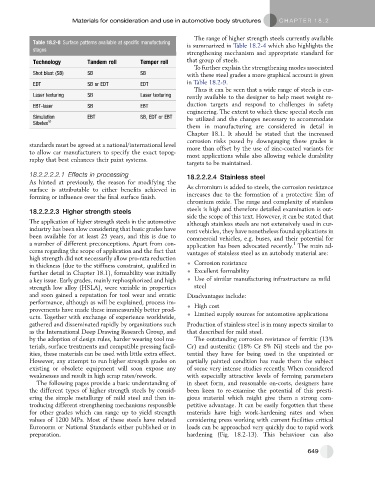Page 641 - Automotive Engineering Powertrain Chassis System and Vehicle Body
P. 641
Materials for consideration and use in automotive body structures C HAPTER 18.2
The range of higher strength steels currently available
Table 18.2-8 Surface patterns available at specific manufacturing
is summarized in Table 18.2-4 which also highlights the
stages
strengthening mechanism and appropriate standard for
Technology Tandem roll Temper roll that group of steels.
To further explain the strengthening modes associated
Shot blast (SB) SB SB with these steel grades a more graphical account is given
in Table 18.2-9.
EDT SB or EDT EDT
Thus it can be seen that a wide range of steels is cur-
Laser texturing SB Laser texturing rently available to the designer to help meet weight re-
EBT-laser SB EBT duction targets and respond to challenges in safety
engineering. The extent to which these special steels can
Simulation EBT SB, EDT or EBT be utilized and the changes necessary to accommodate
Sibetex Ó
them in manufacturing are considered in detail in
Chapter 18.1. It should be stated that the increased
corrosion risks posed by downgauging these grades is
standards must be agreed at a national/international level more than offset by the use of zinc-coated variants for
to allow car manufacturers to specify the exact topog- most applications while also allowing vehicle durability
raphy that best enhances their paint systems.
targets to be maintained.
18.2.2.2.2.1 Effects in processing 18.2.2.2.4 Stainless steel
As hinted at previously, the reason for modifying the
surface is attributable to either benefits achieved in As chromium is added to steels, the corrosion resistance
forming or influence over the final surface finish. increases due to the formation of a protective film of
chromium oxide. The range and complexity of stainless
18.2.2.2.3 Higher strength steels steels is high and therefore detailed examination is out-
side the scope of this text. However, it can be stated that
The application of higher strength steels in the automotive although stainless steels are not extensively used in cur-
industry has been slow considering that basic grades have rent vehicles, they have nonetheless found applications in
been available for at least 25 years, and this is due to commercial vehicles, e.g. buses, and their potential for
a number of different preconceptions. Apart from con- application has been advocated recently. The main ad-
1
cerns regarding the scope of application and the fact that vantages of stainless steel as an autobody material are:
high strength did not necessarily allow pro-rata reduction
in thickness (due to the stiffness constraint, qualified in Corrosion resistance
further detail in Chapter 18.1), formability was initially Excellent formability
a key issue. Early grades, mainly rephosphorized and high Use of similar manufacturing infrastructure as mild
strength low alloy (HSLA), were variable in properties steel
and soon gained a reputation for tool wear and erratic Disadvantages include:
performance, although as will be explained, process im- High cost
provements have made these immeasurably better prod-
ucts. Together with exchange of experience worldwide, Limited supply sources for automotive applications
gathered and disseminated rapidly by organizations such Production of stainless steel is in many aspects similar to
as the International Deep Drawing Research Group, and that described for mild steel.
by the adoption of design rules, harder wearing tool ma- The outstanding corrosion resistance of ferritic (13%
terials, surface treatments and compatible pressing facil- Cr) and austenitic (18% Cr 8% Ni) steels and the po-
ities, these materials can be used with little extra effect. tential they have for being used in the unpainted or
However, any attempt to run higher strength grades on partially painted condition has made them the subject
existing or obsolete equipment will soon expose any of some very intense studies recently. When considered
weaknesses and result in high scrap rates/rework. with especially attractive levels of forming parameters
The following pages provide a basic understanding of in sheet form, and reasonable on-costs, designers have
the different types of higher strength steels by consid- been keen to re-examine the potential of this presti-
ering the simple metallurgy of mild steel and then in- gious material which might give them a strong com-
troducing different strengthening mechanisms responsible petitive advantage. It can be easily forgotten that these
for other grades which can range up to yield strength materials have high work-hardening rates and when
values of 1200 MPa. Most of these steels have related considering press working with current facilities critical
Euronorm or National Standards either published or in loads can be approached very quickly due to rapid work
preparation. hardening (Fig. 18.2-13). This behaviour can also
649

